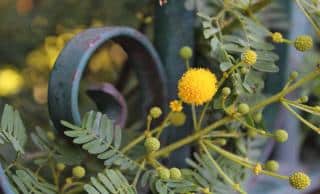

Sun-loving mimosa trees are native to Australia, and in the Northern hemisphere they bloom as if they were still down under. December to March is when flowers appear on most varieties! The English brought first specimens over to the French Riviera around 1850.
Since then, mimosas have naturalized along the Mediterranean, the Atlantic Coast, and even Southern England!
Acacia is the botanical name for the mimosa tree. The genus includes trees of many sizes, all of which bear round, puff-like flowers in shades of yellow, white, or orange. They’re often fragrant. There are over 1200 species in the genus, most of them can’t survive harsh winters.
Luckily, some species such as Acacia baileyana, dealbata and decurrens are happy with occasional frosts along coastlines, to the point they’re sometimes marked as invasive. Their incredibly vigorous root system sends offshoots up at a distance, and they crowd native plants out. Like all plants of the Legume family, they excel at extracting nitrogen directly from the air. They thus thrive even in poor soil.
Acacia dealbata is a favorite for its abundant clusters of fragrant flowers. They hold well in cut flower bouquets, and the tree itself is quite hardy. ‘Le Gaulois’ is a hybrid often used to prepare bouquets, flowers have a dense sulfur-yellow color in January-February, backed with narrow silver-gray leaves (12-18 feet tall or 4-6 m). It is hardy down to 14°F (-10°C). The ‘Mirandole’ is a pretty vigorous cultivar (25 feet/8 meters tall) with dark leaves. It blooms at the end of December.
The 4 seasons mimosa (Acacia retinodes) blooms more sparsley, but the blooming lasts from May to November.
Acacia baileyana ‘Purpurea’ catches the eye. Indeed, it bears violet leaves during half the year.
Acacia covenyi has very intricate leaf patterns. Leaves boast a luminous silvery hue in the summertime.
In temperate climates, trees top out at around 12 to 25 feet (3 to 8 meters), whereas in their native environment, they tower to nearly 100 feet/ 30 meters.
Mimosa trees often experience fast growth. Acacia dealbata grows nearly 3 feet / 1 meter a year for the first 5 years! However, its lifespan rarely exceeds 15 to 20 years. Others can last centuries, like A. melanoxylon.
Their rhizome-like root system is great to retain soil on slopes, but it tends to send offshoots out at a high rate. That’s why most similar species are often grafted onto 4-seasons mimosa rootstock, which has the added advantage of tolerating clay and limestone soil. This also triggers earlier blooming, too.
Generally, mimosa trees that have composite leaves such as Acacia dealbata, baileyana are the hardiest, down to 10-15 °F (-8 to -12°C).
Note that these hardiness ratings depend on many factors: age of the tree, exposure, soil water content, intensity of the cold…
Potted mimosa can be winterized in a cool, bright room, as long as it doesn’t freeze inside. Even without indoor space, your tree can still survive outside in the corner of a garden. Simply protect branches with two layers of winterizing fleece, and mulch the trunk up to the graft point.
If you’ve purchased a mimosa tree that’s already in full bloom, wait for spring before transplanting it to the ground. In the meantime, keep it in the coolest part of the house, and follow-up on watering properly.
This sun-loving plants needs at least 3 hours of direct sunlight every day. Best is to select for it a spot that is sheltered from dominant winds, near a walkway you often walk along: this guarantees you’ll savor its fragrant blooming!
 Prune mimosa after the blooming. This helps the tree grow more dense and round. It also protects the tree from strong winds, and you’ll get many more flower-bearing branches. Feel free to gather blooming sprigs if the tree is vigorous enough!
Prune mimosa after the blooming. This helps the tree grow more dense and round. It also protects the tree from strong winds, and you’ll get many more flower-bearing branches. Feel free to gather blooming sprigs if the tree is vigorous enough!→ Learn more: Mimosa: guidelines to grow and care for it